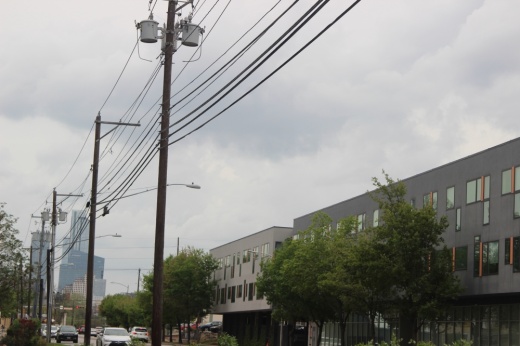The big picture
Severe weather in February 2023 knocked out power to thousands of AE customers and impacted the city's power grid for days. Civic response to the ice storm prompted reviews of AE operations and was soon followed by leadership changes at City Hall and the utility.
Weeks later, City Council asked AE to evaluate the concept of moving overhead power distribution lines underground to improve resiliency and avoid negative weather impacts in the future. Officials also sought to improve processes that could see more power lines placed underground while new projects are developed.
AE's service area includes roughly 12,000 miles of distribution lines, with about 5,000 miles overhead and 7,000 more already situated underground. Last year, the city utility set aside $1 million to study burying more of the network; a grant-funded study into "hardening" overhead lines to withstand more severe conditions is also now in progress.

“While all these efforts have historically been separate initiatives, we now see the need to bring these together with lessons learned together into one Comprehensive Distribution Resiliency Plan later this year,” AE General Manager Bob Kahn said in a statement. “This long-range, ongoing plan will outline Austin Energy's strategies to make our grid more reliable and resilient for decades to come.”
The breakdown
Buried power lines can offer reliability benefits like fewer power outages and lower maintenance costs, as well as improved aesthetics for areas where utility poles and lines are removed. However, the process carries high costs that may not be worthwhile in most of Austin, according to the undergrounding analysis by consultant 1898 & Co.
Converting all 5,000 miles of AE's overhead distribution lines today would cost an estimated $50 billion. City Council members labeled that figure and a system-wide conversion as clearly unrealistic, but expressed a desire to potentially pursue the concept in more limited ways.
1898 reviewed the cost to benefit ratio of burying AE's entire distribution network, broken into thousands of smaller stretches. Of 5,000 segments analyzed, the firm found only 33—covering about 120 miles total—where the benefits of undergrounding could outweigh various costs associated with the process. Citing security protocols, AE is withholding the locations of those segments.
The cost of burying just those 33 sections is projected at about $1.6 billion. And even in those locations, Arlin Mire, 1898's utility investment planning project manager, said AE and city officials should still consider sites on an individual basis before calling for any specific changes.
"The plan is to investigate those more thoroughly to see what challenges may arise. ... [T]hose locations could see benefits from other, less costly resiliency measures as opposed to undergrounding," AE spokesperson Matt Mitchell said in an email. "We’ll see what overlap there is with those sections when the overhead hardening study concludes in May."
Zooming in
Council members also asked to consider whether any of those nearly three dozen segments, or other stretches of overhead line, could be more efficiently buried through infrastructure projects where the city would already be digging.
Mayor Pro Tem Vanessa Fuentes suggested converting lines alongside construction on city infrastructure and the proposed Project Connect light rail lines. The utility hasn't yet confirmed which projects might overlap with priority power lines, according to Lisa Martin, AE's deputy general manager and COO, but she said it's now coordinating with city departments on "opportunities to dig once."
Certain corridors could also benefit from undergrounding as a whole, council member Chito Vela said, especially as new transit and mobility options roll out. He pointed to North Lamar Boulevard between 51st Street and its northern endpoint at I-35 as one area the city could be "opportunistic" about improvements, especially ahead of Project Connect development.
“I just don’t see how we’re going to build the corridor that we want to build when we have so much lines in the right of way," he said. "Thinking about light rail: once it goes up that direction, if we want light rail we need to make room for the vehicles, we need to make room for bike lanes, nice sidewalks. And there are these huge metal poles ... right in the middle of the right of way."
Staff and officials also noted that, while thousands of miles remain aboveground, the vast majority of new development in town is now being built out with power lines below-ground.
AE already has voluntary undergrounding standards for work like that, and council member Ryan Alter said new policies could be considered to further incentivize the practice in places it's most feasible or where higher growth is expected. Vela also suggested optional pilot programs to test the process in neighborhoods that'd want to see their lines buried.
"An attempt in a limited scale ... might help us flesh out some of the concerns; might help us realize that this is easier than we thought, this is harder than we thought, whatever the case may be," he said.
What's next
After the initial 1898 report, Martin said AE is continuing to evaluate the undergrounding findings. City Council's Austin Energy Oversight Committee is scheduled to review the companion Overhead Hardening Study in May.
Based on both studies, further analysis and stakeholder engagement, the utility will then put together its broader distribution plan before the end of 2025.





